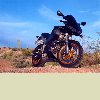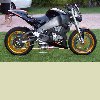| Author | Message | ||
Morts |
PLUGS So, is there really a lot of difference between brands? Do you get a tangible increase in performance? or is this more hype What do you all reckon Cheers Morts | ||
Buellman39 |
To be honest after racing for 12 years I have not found much difference between manufacturers. As long as you choose a good brand NGK, DENSO or so on you will be more than happy for street riding. Chad | ||
Wyckedflesh  |
It's not so much what kind of power each produces, but its longjevity. If you are using the correct heat range, is the plug going to last. With that said, I have NGK Iridiums that keep suprising me. I fouled out the front plug due to really short riding and then a hurried shutdown without letting it idle a bit first. I don't think the bike actually got warmed up enough and that is shame on me. However, I just took the bike for an 850 mile round trip in some nasty last half weather and gee...that fouled plug isn't acting up at all. It would stumble like a cylinder misfired and now its back to being totally smooth. To me that is a sign of a good plug. 3000 miles on this set btw. | ||
Midknyte |
Can / will a plug un-foul itself with a good long ride? | ||
M1combat  |
It depends on just how fouled it was to begin with... Just FYI... 10K miles on my factory plugs so far. I'll replace them with the same thing. | ||
Xb9er  |
NGK Iridium plugs on my XB with about 8,500 miles ridden with them. The bike has always run smoothly with them. No misfires or backfires. Mike. | ||
Ingemar  |
I did notice that new plugs and good wires did make the bike run smoother. Picked up a little better from lower revs. I don't believe in more power (in terms of hp's) from one plug or another. | ||
Xbolt12 |
The part number for the colder NGK Iridium is #2316 or DCPR9EIX. I think Trojan may have mixed the numbers up when he posted. NGK lists KR8AI but this is an 8 heat range which corresponds to the old recommended heat range for older Buell which originally ran a hotter plug than the stock Harley 10R12A plug which Buell later recommended for all Buells. At least this is my new understanding. (Did I get that right Al?) I have checked all the specs and the part number came from NGK's tech support, so I'll try them and post after I have some time on them. I do have to wonder how many people having trouble with pinging are running the 8's? Seems like running a 9 heat range (NGK range numbers only apply to NGK plugs)NGK might help. Anyone know what plugs Trenchtractor runs? xbolt12 | ||
Al_lighton  |
John, I'm not certain about the iridium number, but I know the NGK non-iridium heat range that corresponded to the 10R12 HD plug is a 9. I don't think NGK changed their recommendations from an 8 to a 9 heat range when Buell changed their recommendation from 6R12's to 10R12's. I've always run NGK heat range 9 plugs in all my Buells and haven't fouled one yet, even with the bikes tuned fat. | ||
Dcmortalcoil |
DCPR9E corresponds to Denso IXU27 iridium spark plugs. | ||
Trenchtractor  |
The Australian NGK number is DCPR7EIX... I'm not sure what the spec's are on the different numbers... Perhaps the 9 are used for the UK, the 8 for USA and the 7 for Oz due to different climates... Perhaps the reative plugs for each region are all the same spec and the part number is different. I'd like a spec sheet comparison between the 3 numbers for their home market... | ||
Xb9er  |
XBolt12. When you say NGK recommends a colder plug (DCPR9EIX) is that for the XB12 only or are they also talking about the XB9? I use the KR8AI in my XB9R and I don't notice pinging. I'll have to check their condition to see how they have held up for the past 6,000 miles or so. Mike. | ||
Lonexb  |
i have just about 11k on my stock plugs.only took them out once around 8k.they were in good shape,so i cleaned them and put them back in. | ||
Ezblast  |
Denso Irridium - 10R12A - to - DPR9EA-9 - to - IX27B - their number is the plug I've always ran - when I switched to Iridium - before that I ran the hotter plug which with a lean intake can spell rebuild time - lol GT - JBOTDS! EZ  | ||
Xbolt12 |
Trench, Yikes man! Get that hot plug outa there! That is the same series plug as the heat range 9 that I just received in yesterdays mail. NGK support said that heat ranges by number are the same throughout the NGK line-that would mean you for sure are one heat range too hot and most likely two heat ranges too hot. BTW the plugs were around 6 dollars US each. xb9er, NGK didn't say the 9 was the equivalent plug to the stock Buell heat range, they said it was the correct plug specs but one heat range cooler. They claim the 8 heat range is equivalent to the 10R12A , but if you read my post again and Al Lighton's response you will probably come to the conclusion that the 9 is actually the same heat range as the 10R12A Harley/Buell stock plug. The theory here is that NGK is still using the old part number cross when Buell had not yet gone to the 10R12A (colder heat range) plug. If that is the case then the NGK heat range should be a 9 not an 8, but certainly not a 7. Anyway I would rather be a heat range colder than stock than risk a heat range hotter than stock the way I flog my bike. (Don't tell Anonymous in case I have a warranty issue  With all that said, I would like to point out that the pinging I reported in earlier posts was with stock 10R12A plugs. xbolt12 | ||
Trenchtractor  |
Ahhh... Xbolt, I'm looking at the Aussie number DCPR7EIX... You'll notice that the letters are different, too... Even though the heat ranges by number are the same throughout the NGK line in the USofA, and the heat ranges by number are certainly the same throughout the NGK line here in Oz... I wonder if, over the two different markets, the heat ranges by number actually line up... That's my question. That's why I'd like to see the temp spec's on your '9's and my '7's side by side for a direct comparo... | ||
Xbolt12 |
Trench, Check out this link for NGK part number descriptions: (you will need Acrobat). http://www.ngksparkplugs.com/techinfo/spark_plugs/partnumberkey.pdf Also check out this link for more info on heat ranges: http://www.ngksparkplugs.com/techinfo/spark_plugs/techtips.asp?nav=31000&country = I am pretty sure those NGK part numbers are world wide. Hope you understand I am not trying to be critical, I just think I've stumbled onto something that can help us all avoid the dreaded ping. xbolt12 | ||
Trenchtractor  |
Thanks Xbolt, interesting to note the following points: 'the spark plug tip temperature must remain between 500C-850°C. If the tip temperature is lower than 500°C, the insulator area surrounding the center electrode will not be hot enough to burn off carbon and combustion chamber deposits. These accumulated deposits can result in spark plug fouling leading to misfire. If the tip temperature is higher than 850°C the spark plug will overheat which may cause the ceramic around the center electrode to blister and the electrodes to melt. This may lead to pre-ignition/detonation and expensive engine damage.' And: 'In identical spark plug types, the difference from one heat range to the next is the ability to remove approximately 70°C to 100°C from the combustion chamber.' And: 'A colder heat range is necessary when the engine is modified for performance, subjected to heavy loads, or is run at high rpms for a significant period of time. The colder type removes heat more quickly, and will reduce the chance of pre-ignition/detonation and melting or damage to the firing end. ' And please take note of NGK's take on Pre-ignition and Detonation... Pre-ignition Defined as: ignition of the air/fuel mixture before the pre-set ignition timing mark Caused by hot spots in the combustion chamber...can be caused (or amplified) by over advanced timing, too hot a spark plug, low octane fuel, lean air/fuel mixture, too high compression, or insufficient engine cooling A change to a higher octane fuel, a colder plug, richer fuel mixture, or lower compression may be in order You may also need to retard ignition timing, and check vehicle's cooling system Pre-ignition usually leads to detonation; pre-ignition an detonation are two separate events Detonation The spark plug's worst enemy! (Besides fouling) Can break insulators or break off ground electrodes Pre-ignition most often leads to detonation Plug tip temperatures can spike to over 3000°F during the combustion process (in a racing engine) Most frequently caused by hot spots in the combustion chamber. Hot spots will allow the air/fuel mixture to pre-ignite. As the piston is being forced upward by mechanical action of the connecting rod, the pre-ignited explosion will try to force the piston downward. If the piston can't go up (because of the force of the premature explosion) and it can't go down (because of the upward mo-tion of the connecting rod), the piston will rattle from side to side. The resulting shock wave causes an audible pinging sound. This is detonation. Most of the damage than an engine sustains when "detonating" is from excessive heat The spark plug is damaged by both the elevated temperatures and the accompanying shock wave, or concussion Made for very interesting reading... And given that their figure for the difference between 1 heat range is 70-100 degrees, I think it's something we should be looking at as victims of the detonation issue... Especially given their advice on engines modified for performance... | ||
Trenchtractor  |
Also, it has come to my attention that NGK Australia don't list the XB's yet. That number I gave earlier was one supplied to me, but is for the earlier models... It's probably fine for the models with a lower state of tune. I am still running the stock plugs, I've been waiting to figure out the right plug for the job before purchasing... Iridiums will be the go, but the right number is the concern... Now I am going to hit the NGK rep up for a '9' plug and see what he says... Advice from the auto industry here was to go for a hotter plug, obviously for better performance, but what is the point of better performance if your engine only lasts 5,000k's... | ||
Xbolt12 |
Trench, Hotter plugs are almost never the way to go for performance unless you are fouling plugs and even then it is risky. BTW I found an intake leak on my bike while trying to get the #@%!! sparkplug wires on. Check out my post on intake leak on CA bikes. xbolt12 | ||
Biofilter |
Ok so final answer time.... what is the exact model number NGK plug that is the cooler heat range? | ||
Daveymac |
Quote: Ok so final answer time.... what is the exact model number NGK plug that is the cooler heat range? Bump  |